#fossil preservation
Explore tagged Tumblr posts
Text

BIG PLESIOSAUR NEWS I'm delighted to finally reveal the illustration I produced for the paper "Skin, scales, and cells in a Jurassic plesiosaur"!


While already excavated in 1940 this specimen was only really prepared in 2020 and new analysis methods revealed a wealth of details, many unseen until now.

Some of the coolest finds are thickened skin folds, remands of a possible tail fluke and scales on the paddles.
Beyond these superficial elements these specimen also has cellular details preserved. Among them melanophore traces hinting at the pigmentation of the animal.
You can read more about it in the publication! Also, stay tuned for more stuff regarding fossils from Holzmaden!
https://www.cell.com/current-biology/fulltext/S0960-9822(25)00001-6
#paleoart#sciart#paleostream#palaeoblr#jurassic#plesiosaur#plesiopterys#holzmaden#posidonia shale#fossil preservation
4K notes
·
View notes
Text
Dinosaurs had cancer 70 million years ago, new study offers clues for cancer treatment | - The Times of India
Dinosaurs, the colossal rulers of prehistoric Earth, were not immune to the ailments that still plague modern animals, including cancer. In a groundbreaking discovery, scientists have confirmed that a duck-billed dinosaur that lived 70 million years ago suffered from a benign tumour. The fossilised remains of Telmatosaurus Transsylvanicus, found in present-day Romania, contained evidence of a jaw…
#ancient diseases#cancer treatment#Dinosaurs and cancer#evolution of cancer#fossil preservation#Paleontology
1 note
·
View note
Text
I've been trying to find out more about Israel and Palestine outside the conflicts, what they're like as places.
And I love dinosaurs. So naturally, I was curious as to whether any dinosaurs had ever been found there.
And the answer is yes!
I found this article by Haaretz, among other sources:
There is, to date (or at least according to this article, and so far as I can find from other sources), ONE single dinosaur fossil in Israel- a set of 200 or so footprints which are being gradually eroded (note: this may be out of date- Wikipedia's article on Beit Zayit mentions the dinosaur tracks, and says that they "are on display at the Hebrew University of Jerusalem.").
There are also apparently a fair amount of marine fossils from that period, due to the area being underwater at the time, as well as stuff from more recent times, like mammoths (and, though not mentioned in the Haaretz article, early hominids).
I was saddened to read that there is no major natural history museum with a collection of such fossils in Israel. But it reminds me actually quite a bit of the situation here, on the West Coast of Canada. Our local museums don't have much in the way of dinosaurs, usually, and their fossils are extremely rare here- but there's a fair amount of marine life from that time period.
The debate over whether to leave fossils in nature where they are found, or preserve them in museums (especially if they are in imminent danger) is interesting. I appreciate the mention of scanning fossils as an option.
I must critique whoever wrote/edited this thought for a couple of errors near the top of the article- first a sloppy choice of wording that appeared to conflate dinosaurs and marine reptiles (this is clearly just unclear wording, not lack of knowledge, as later in the article the distinction is made repeatedly clear), and secondly the author saying they saw 56 million year old dinosaur tracks (the K/T extinction happened 66 million years ago, so while I'm not sure of the age of the fossils in question, I suspect a typo of 5 instead of 6 is responsible here).
Incidentally, if anyone's curious as to which dinosaur was found in Israel, the footprints have been inconclusively attributed to the genus Elaphrosaurus, a late Jurassic therapod that, unlike most therapods, may have been herbivorous or omnivorous rather than a carnivore:
(The skeleton here is a somewhat speculative reconstruction, as no skull has ever been found.)
Here is a guess as to what it might have looked like when it was alive:

(Whether it had feathers is, so far as I can find, an open question.)
And for scale:

(Photos are from the Wikipedia article.)
Edit: Some further research found that there have also been some dinosaur tracks found in Ramallah, in the West Bank, and specifically at Al-Bireh (I'm not clear if this is the only site).
YNetNews says that a study at Al-Quds University identified them as either theropod or ornithischian tracks:
Theropods are the group of dinosaurs, primarily carnivores, from which birds evolved, and also included Tyrannosaurs, Velociraptor, etc. Ornithischians were another group, mostly plant-eaters, and ironically their name means "bird-hipped", despite birds being therapods.
According to the article, the genus and species is unknown, but the tracks were apparently made by two individuals, possibly the same species and possibly at the same time, and by a biped. Further, they appear to show some interesting behaviour, specifically the animal trying to get food out of its teeth by digging in the mud. They're also apparently from a bit more recently than the Beit Zayit tracks, being from the Late Early Cretaceous instead of the Late Jurassic (at least, I assume the Beit Zayit tracks are Late Jurassic if they're thought to be Elaphrosaurus).
I must critique this article, though, for the gross errors of referring to the theropoda, a vast group containing thousands of species, as a subspecies, and the possibly even vaster and incredibly diverse Ornithischia as a "chicken-like species". This is... quite possibly the worst butchering of palaeontology that I've ever seen in an article, and honestly makes me doubt everything else in it, at least beyond the fact that the tracks exist.
#Israel#Palestine#The Levant#Natural History#Science#Palaeontology#Dinosaurs#Trackways#Fossil Tracks#Museums#Fossil Preservation#Education#Environmentalism
0 notes
Text

Psittacosaurus
#paleoart#dinosaurs#donation rq#the slight brighter colors underneath the tail are because this is the only dinosaur whos actual ass got fossilized#it preserved some sort of color (probably dark) but ive chosen to make it blue#in honor of a person i follow on twitter who gets really angry when dinosaurs in movies have any color besides dust brown ❤️#my art
5K notes
·
View notes
Text
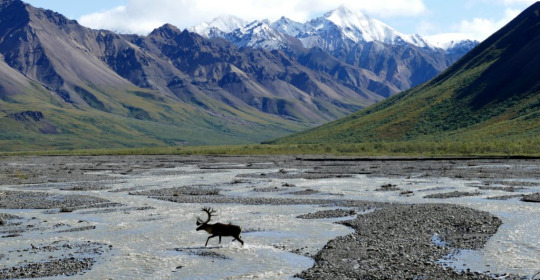
From the article:
The Department of the Interior today announced that the Bureau of Land Management received no bids for the congressionally mandated oil and gas lease sale for the Coastal Plain of the Arctic National Wildlife Refuge (Arctic Refuge). The deadline to submit bids was Monday, January 6. [...] “The lack of interest from oil companies in development in the Arctic National Wildlife Refuge reflects what we and they have known all along – there are some places too special and sacred to put at risk with oil and gas drilling. This proposal was misguided in 2017, and it’s misguided now,” said Acting Deputy Secretary Laura Daniel-Davis.
This is the second time that the lease sale for this area has fallen through. The writing is on the wall that investments like this have an expiration date as the world transitions to clean energy due to economics and public opinion.
#arctic national wildlife refuge#arctic drilling#climate change#global warming#good news#hope#hopepunk#environment#habitat preservation#fossil fuels#clean energy#oil companies#ecoanxiety#climate anxiety#climate grief
1K notes
·
View notes
Text
blessed be the gifmakers. blessed be the writers. blessed be the artists. blessed be the meta. blessed be the analysts. may your dash always load in HD. may your photoshop never glitch. may your wifi always be steady. may your inspiration be there when you need it. the world is hostile and stupid out there and we are on this hellsite making things and reclaiming space and having fun. love u all
#not to get sentimental over the fossil fuel sport but#i cannot emphasise how important it is to preserve our inherent sense of passion and whimsy in these trying times or anytime ever#it’s really a saving grace scrolling the tags and seeing the insane amount of talent each and every time#you’re all amazing and make f1blr worth it#mwah mwah#fandom stuff#wiz.yaps
69 notes
·
View notes
Text
May or may not be cramming to make last minute art fight refs. Anyways I'm on team fossils this year so I decided to design a fossily dragon guy!
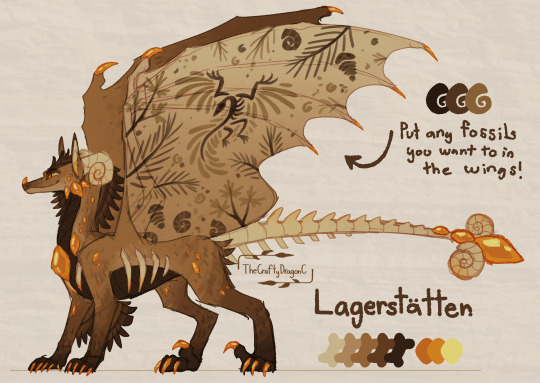
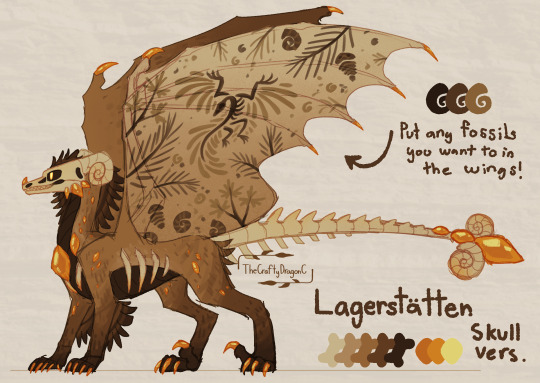
His link if anyone is interested 👉👈 Art Fight - Character : Lagerstätten Going to be trying to revenge everyone like usual! No promises though.
#my art#dragon#dragon art#undescribed#my design#art fight#art fight 2025#art fight team fossils#fun fact Lagerstatten is the name of a sedimentary deposit with an abundance of well preserved fossils#anyways back to ref sheet hell I go
41 notes
·
View notes
Text
353 notes
·
View notes
Text
Monday Musings: Why are there so many perfectly preserved soft-bodied animals found in the Cambrian?
There are a number of ways to get the perfect preservations needed to fossilize soft parts but none of them are particularly common. On the other hand, most of them require water and there was quite a lot of it 518 million years ago.
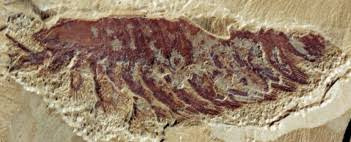
Phosphatization occurs when large quantities of phosphate are present, either in sea water or from the tissues of a decaying organism. In some cases, microbes that fed on the tissue control the phosphatization. Many soft tissues are preserved this way in the Burgess Shale. The phosphate comes from the tissue itself and when pH is low and oxygen is absent, it becomes the primary method of fossilization.
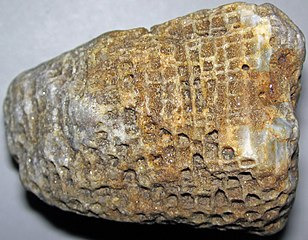
Silicification is one of the most common ways to fossilize something because silicates is the most common rock forming minerals in the crust. Silica often replaces other minerals that have dissolved out such as calcite shells. This is usually seen to preserve things like trilobites. It doesn't often fossilize soft tissue.
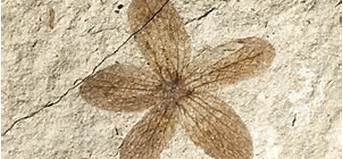
Another form of preservation found at least in the Burgess Shale is carbonaceous film. This occurs when something is buried under several layers of sediment and diagenetically altered (in this case by heat and pressure brought on by compaction) and the animal lacks a hard skeleton or shell.
When we look at quarry locations on a paleo map,
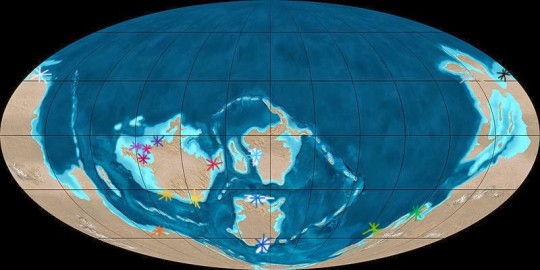
and examine the rocks, we see that they lived and died in the right place at the right time (if the taphonomic and preservation bias don't lead us astray).

The Burgess Shale beds were deposited at the base of a cliff of calcareous reefs below the depth agitated by waves during storms. The most widely accepted hypothesis for burial is that part if the reef became detached, slumped and transported rock and debris several kilometers and quickly burying anything in its path.

On the other hand, the Maotianshan Shale was probably buried periodically under turbidity currents, basically an underwater mass wasting event. This is why we don't build our homes on old landslide deposits kids.

The Sirius Passet lagerstatte of Greenland was yet a different environment close to the boundary of an oxygen minimum zone according to geochemical analysis. It is thought that the original preservation was phosphatization that was later altered to silica by low grade metamorphism during the Devonian Period mountain-building events.
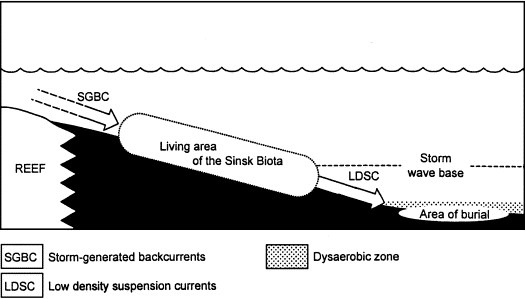
Finally, we have the Sinsk Biota of Siberia which inhabited an open marine basin where storms created back currents that sent many animals off into the oxygen depleted depths below. Anoxic conditions prevent growth of microbes that would normally decay flesh allowing soft tissues to preserve.
Now, it is also important to note that oftentimes, parts labeled soft tissue are not necessarily as soft as you believe. Take keratin for example which makes up nails, hair, feathers and sheaths over horns. It's not really that soft in some cases but it is softer than bone which makes it harder to preserve.
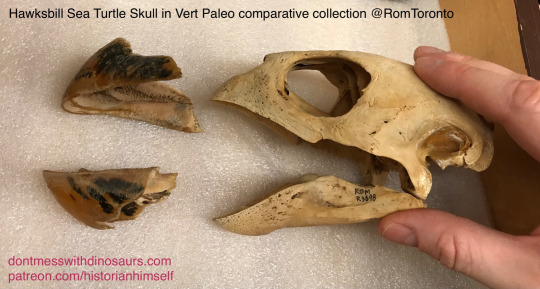
Whether we mean keratin or chitin (a natural polymer used to strengthen fungi and invertebrates) or internal organs which really are soft tissues, the Cambrian lagerstatten really are something else.
#paleontology#fossils#geology#mineralogy#fossilization#preservation#taphonomy#paleoecology#cambrian period#cambrian explosion
66 notes
·
View notes
Text

And 3rd attack on my good buddy @plushyking !!!
#my art#digital art#others ocs#artists on tumblr#artfight 2025#artfight#team fossils#i will be getting you back better later mark my words#might limit myself to 3 finished attacks a day.....to preserve motivation thru the month#the rest of tonight is just for sketching the next two days attacks YIPPEE
10 notes
·
View notes
Text

Flynn likes to be involved with everything I do. If he sees me crouch down to look at something &/or pick it up, he likes to come & inspect it as well. In case it's interesting. Or edible. Or both.
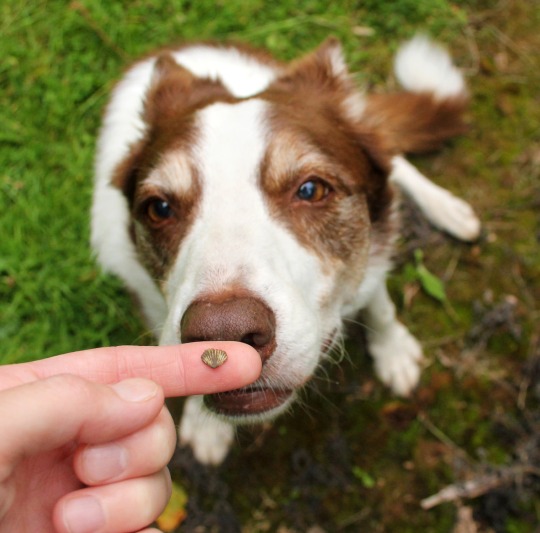
In this case, I'd found a fossil. According to Flynn this falls in the "Not Interesting" category but he gave it a polite sniff all the same. Like I politely praise him when he finds & shows me puddles & molehills. We humour each other.
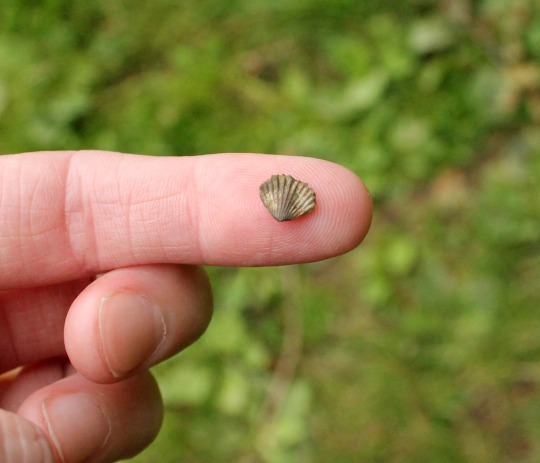
Such a teeny tiny fossil! It's one of the smallest I've found. Probably at least 420 million years old, which is just completely wild.
#I've got a fair sized collection of fossils now#mostly either brachiopods - which look like bi-valve molluscs but aren't... & corals#some of the shell fossils are very well preserved & almost look like they came off a beach that day!#I find them on farmland - ploughing turns the soil & they pop up to the surface. also there are 1 or 2 old quarries in the woods#this one was on the footpath - I bent down to pick up Flynn's toy & spotted it#silurian#fossil#shell#england#dog#flynn
227 notes
·
View notes
Text
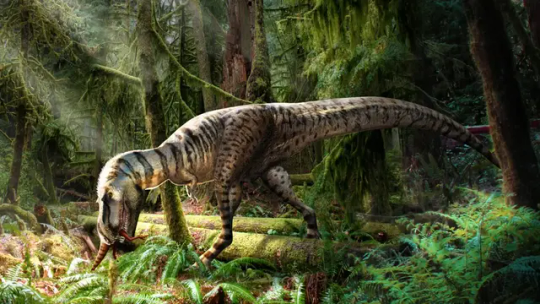
First tyrannosaur fossil discovered with its last meal perfectly preserved in its stomach
Researchers have found a tyrannosaur’s last meal perfectly preserved inside its stomach cavity.
What was on the menu 75 million years ago? The hind legs of two baby dinosaurs, according to new research on the fossil published Friday in the journal Science Advances.
Dinosaur guts and hard evidence of their diets are rarely preserved in the fossil record, and it is the first time the stomach contents of a tyrannosaur have been uncovered.
The revelation makes this discovery particularly exciting, said co-lead author Darla Zelenitsky, a paleontologist and associate professor at the University of Calgary in Alberta.
“Tyrannosaurs are these large predatory species that roamed Alberta, and North America, during the late Cretaceous. These were the iconic apex or top predators that we’ve all seen in movies, books and museums. They walked on two legs (and) had very short arms,” Zelenitsky said.
“It was a cousin of T. rex, which came later in time, 68 to 66 million years ago. T. rex is the biggest of the tyrannosaurs, Gorgosaurus was a little bit smaller, maybe full grown would have been 9, 10 meters (33 feet).”
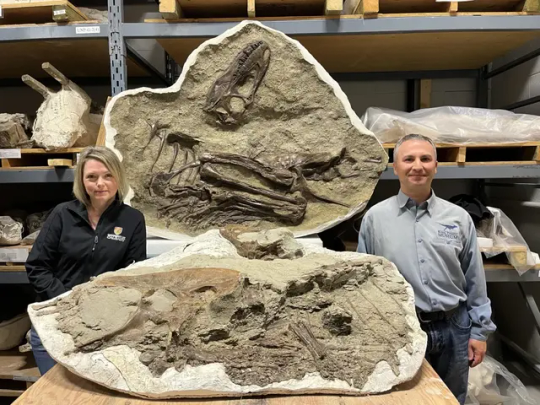
The tyrannosaur in question, a young Gorgosaurus libratus, would have weighed about 772 pounds (350 kilograms) — less than a horse — and reached 13 feet (4 meters) in length at the time of death.
The creature was between the ages of 5 and 7 and appeared to be picky in what it consumed, Zelenitsky said.
“Its last and second-to-last meal were these little birdlike dinosaurs, Citipes, and the tyrannosaur actually only ate the hind limbs of each of these prey items. There’s really no other skeletal remains of these predators within the stomach cavity. It’s just the hind legs.
“It must have killed … both of these Citipes at different times and then ripped off the hind legs and ate those and left the rest of the carcasses,” she added. “Obviously this teenager had an appetite for drumsticks.”
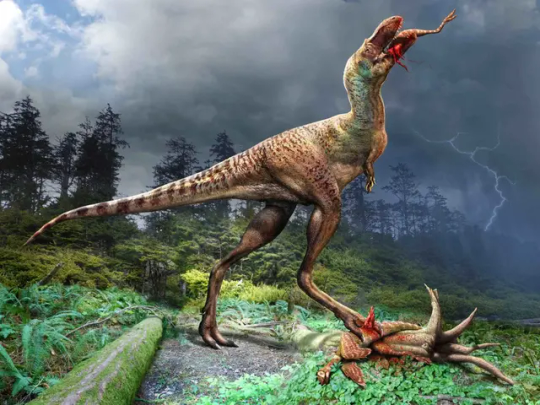
The two baby dinosaurs both belonged to the species called Citipes elegans and would have been younger than 1 year old when the tyrannosaur hunted them down, the researchers determined.
The almost complete skeleton was found in Alberta’s Dinosaur Provincial Park in 2009.
That the tyrannosaur’s stomach contents were preserved wasn’t immediately obvious, but staff at the Royal Tyrrell Museum in Drumheller, Alberta, noticed small protruding bones when preparing the fossil in the lab and removed a rock within its rib cage to take a closer look.
“Lo and behold, the complete hind legs of two baby dinosaurs, both under a year old, were present in its stomach,” said co-lead author François Therrien, the museum’s curator of dinosaur paleoecology, in a statement.
The paleontologists were able to determine the ages of both the predator and its prey by analyzing thin slices sampled from the fossilized bones.
“There’s growth marks like the rings of a tree. And we can essentially tell how old a dinosaur is from looking at those, the structure of the bone,” Zelenitsky said.
Changing appetites of top predators
The fossil is the first hard evidence of a long-suspected dietary pattern among large predatory dinosaurs, said paleoecologist Kat Schroeder, a postdoctoral researcher at Yale University’s department of Earth and planetary science, who wasn’t involved in the research.
The teen tyrannosaur didn’t eat what its parents did. Paleontologists believe its diet would have changed over its life span.
“Large, robust tyrannosaurs like T. rex have bite forces strong enough to hit bone when eating, and so we know they bit into megaherbivores like Triceratops,” Schroeder said via email. “Juvenile tyrannosaurs can’t bite as deep, and therefore don’t leave such feeding traces.”
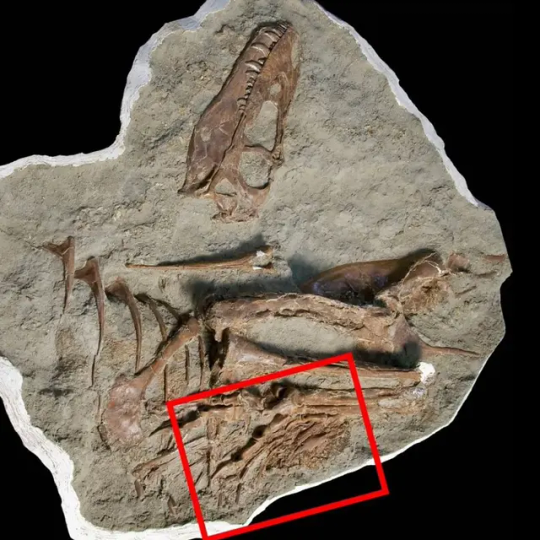
She said that scientists have previously hypothesized that young tyrannosaurs had different diets from fully developed adults, but the fossil find marks the first time researchers have direct evidence.
“Combined with the relative rarity of juvenile tyrannosaur skeletons, this fossil is very significant,” Schroeder added. “Teeth can only tell us so much about the diet of extinct animals, so finding stomach contents is like picking up the proverbial ‘smoking gun.’”
The contents of the tyrannosaur’s stomach cavity revealed that at this stage in life, juveniles were hunting swift, small prey. It was likely because the predator’s body wasn’t yet well-suited for bigger prey, Zelenitsky said.
“It’s well known that tyrannosaurs changed a lot during growth, from slender forms to these robust, bone-crushing dinosaurs, and we know that this change was related to feeding behavior.”
When the dinosaur died, its mass was only 10% of that of an adult Gorgosaurus, she said.
How juvenile tyrannosaurs filled a niche
The voracious appetite of teenage tyrannosaurs and other carnivores has been thought to explain a puzzling feature of dinosaur diversity.
There are relatively few small and midsize dinosaurs in the fossil record, particularly in the Mid- to Late Cretaceous Period — something paleontologists have determined is due to the hunting activities of young tyrannosaurs.
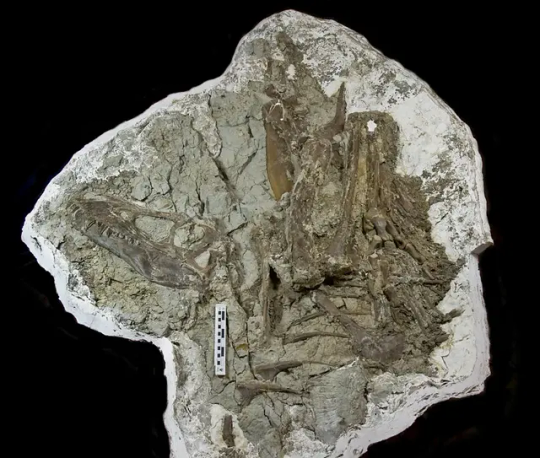
“In Alberta’s Dinosaur Provincial Park, where this specimen is from, we have a very well sampled formation. And so we have a pretty good idea of the ecosystem there. Over 50 species of dinosaurs,” Zelenitsky said.
“We are missing mid-sized … predators from that ecosystem. So yeah, there’s been the hypothesis that, the juvenile tyrannosaurs filled that niche.”
By Katie Hunt.


#First tyrannosaur fossil discovered with its last meal perfectly preserved in its stomach#tyrannosaur#Gorgosaurus libratus#Citipes#Citipes elegans#dinosaurs#paleontologist#Alberta’s Dinosaur Provincial Park#archeology#archeolgst#history#history news#ancient history
83 notes
·
View notes
Text
hoping im alone as a paleontology & archaeology lover in having my weird mini-panic-attacks thinking about historic/prehistoric artifacts being accidentally destroyed
#even things in abundance like mosasaur fossils im freaking out in my bedroom like we need to preserve EVERY ONE OF THEM#how can we bare to even think of losing ONE#we must tread every inch of earth with such delicacy like please
9 notes
·
View notes
Text
i think i have too many online internet names and i will continue to collect them
4 notes
·
View notes
Note
aliens in 1 million years when they see the remains of your luke shrine: hmmm… interesting… humans worshipped a deity named ‘raven’… these acrylic stands must have been used for ritualistic purposes…
asdajbf;ks;LKN;ALKS;FK;SAASLFAAK THEY WOULD BE SO CONFUSED......
#im also laughing at the implication that these acrylic pieces of plastic will be preserved like fossils#asks#anon
10 notes
·
View notes
Text

The best-preserved dinosaur ever discovered is a fossilized nodosaurus that is over 112 million years old, found in Alberta, Canada, in 2011. This remarkable specimen is so well-preserved that its skin patterns, armor plates, and even traces of its original pigmentation are still visible. It was discovered by accident in a mine, perfectly mummified with its limbs, body shape, and face intact, giving an unprecedented glimpse into the appearance of dinosaurs. Scientists believe it was swept into an ancient sea, where minerals rapidly preserved its body, creating a lifelike fossil. Now displayed at the Royal Tyrrell Museum, this nodosaurus is hailed as one of the most significant paleontological discoveries, offering invaluable insights into dinosaur biology and evolution.
More details/photos: https://www.beautyofplanet.com/recently-discovered-dinosaur-mummy-is-so-well-preserved-it-even-has-the-skin-and-guts-intact/
📸Image credit: Royal Tyrrell Museum
5 notes
·
View notes